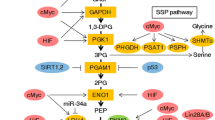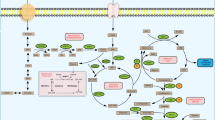Abstract
Ornithine decarboxylase (ODC) and S-adenosylmethionine decarboxylase (SAMDC) expression was investigated in NIH-3T3 fibroblasts that secrete K-FGF. Correlations between altered ODC and SAMDC expression and malignant potential were determined. Increased ODC and SAMDC expression was associated with increased expression of both ODC and SAMDC mRNA and enzyme activity levels. Transcriptional and post-transcriptional regulatory mechanisms were found to account for the increased expression of both ODC and SAMDC. Amplification of the ODC gene also played a role. Correlations between the expression of ODC and the invasion ability of the K-FGF overexpressing cells were also found. Additionally, putrescine, which is a cellular polyamine, was found to play a role in determining the nature of the invasive capacity of the K-FGF overexpressing cells. The results of this study which established correlations between alterations in the expression of ODC and SAMDC, the key rate limiting and regulatory activities in the synthesis of cellular polyamines, and malignant potential as a consequence of K-FGF overexpression supports a model which suggests that growth factor modulation of ODC and SAMDC expression is part of the altered growth regulatory program associated with cellular transformation and malignant progression.
Similar content being viewed by others
References
Wright JA, Egan SE, Greenberg AH: Genetic regulation of metastatic progression. Anticancer Res 10: 1247–1255, 1990
Wright JA, Turley EA, Greenberg AH: Transforming growth factor beta and basic fibroblast growth factor as promoters of tumor progression to malignancy. Crit Rev Oncogene 4: 473–492, 1993
Egan SE, Jarolim L, Rogelj S, Spearman M, Wright JA, Greenberg AH: Growth factor modulation of metastatic lung colonization. Anticancer Res 10: 1341–1346, 1990
Tiesman J, Rizzino A: Expression and developmental regulation of the K-FGF oncogene in human and murine embryonal carcinoma cells. In Vitro Cell Dev Biol 25: 1193–1201, 1989
Yoshida MC, Wada M, Satoh H, Yoshida T, Sakamoto H, Miyagawa K, Yokota J, Koda T, Kakinuma M, Sigimura T, Terada M: Human HST1 (HSTF1) gene maps to chromosome band 11q13 and coamplifies with the INT2 gene in human cancer. Proc Natl Acad Sci USA 85: 4861–4864, 1988
Theillet C, LeRoy X, DeLapeyriere O, Grosgeorges J, Adnane J, Raynaud SD, Simony-Lafonatine J, Goldfarb M, Escot C, Birnbaum D, Gaudray P: Amplification of FGF-related genes in human tumors: Possible involvement of HST in breast carcinomas. Oncogene 4: 915–922, 1989
Damen JE, Greenberg AH, Wright JA: Transformation and amplification of the K-fgf proto-oncogene in NIH-3T3 cells and the induction of metastatic potential. Biochim Biophys Acta 1097: 103–110, 1991
Taylor WR, Greenberg AH, Turley EA, Wright JA: Cell motility, invasion and malignancy induced by overexpression of K-FGF or bFGF. Exp Cell Res 204: 295–301, 1993
Delli-Bovi P, Curatola AM, Newman KM, Sato Y, Moscatelli D, Hewick RM, Rifkin DB, Basilico C: Processing, secretion, and biological properties of a novel growth factor of the fibroblast growth factor family with oncogenic potential. Mol Cell Biol 8: 2933–2941, 1988
Pegg AE: Polyamine metabolism and its importance in neoplastic growth and as a target for chemotherapy. Cancer Res 48: 759–774, 1988
Hurta RAR, Greenberg AH, Wright JA: Transforming growth factor beta1 selectively regulates ornithine decarboxylase gene expression in malignant H-ras transformed fibrosarcoma cell lines. J Cell Physiol 156: 272–279, 1993
Hurta RAR, Wright JA: Ornithine decarboxylase gene expression is aberrantly regulated via the cAMP signal transduction pathway in malignant H-ras transformed cell lines. J Cell Physiol 161: 383–391, 1994
Hurta RAR, Huang A, Wright JA: Basic fibroblast growth factor selectively regulates ornithine decarboxylase gene expression in malignant H-ras transformed cells. J Cell Biochem 60: 572–583, 1996
Kontula KK, Torkkeli TK, Bardin W, Janne OA: Androgen induction of ornithine decarboxylase mRNA in mouse kidney as studied by complementary DNA. Proc Natl Acad Sci USA 81: 731–735, 1984
Kahana C, Nathans D: Translational regulation of mammalian ornithine decarboxylase by polyamines. J Biol Chem 260: 15390–15393, 1985
Persson I, Oredsson SM, Aanehus S, Heby O: Ornithine decarboxylase inhibitors increase the cellular content of the enzyme: Implications for translational regulation. Biochem Biophys Res Commun 131: 239–245, 1985
Hovis JG, Stumpo DJ, Halsey DL, Blackshear PJ: Effects of mitogens on ornithine decarboxylase activity and messenger RNA levels in normal and in protein kinase C-deficient NIH-3T3 fibroblasts. J Biol Chem 261: 10380–10386, 1986
Sertich GJ, Pegg AE: Polyamine administration reduces ornithine decarboxylase activity without affecting its mRNA content. Biochem Biophys Res Commun 143: 424–430, 1987
Heby O, Persson L: Molecular genetics of polyamine biosynthesis in eukaryotic cells. Trends Biochem Sci 15: 153–158, 1990
Pegg AE, McCann PP: S-adenosylmethionine decarboxylase as an enzyme target for therapy. In: W.C. Bowman, A.M. Breckenridge, A.C. Sartorelli (eds). Pharmacological Therapeutics, vol. 56. Pergamon Press, New York, 1992, pp 359–377.
Wallon UM, Shassetz LR, Cress AE, Bowden GT, Gerner EW: Polyamine-dependent expression of the matrix metalloproteinase matrilysin in a human colon cancer-derived cell line. Mol Carcinogen 11: 138–144, 1994
Ray R, Zimmerman BJ, McCormack SA, Patel TB, Johnson LR: Polyamine inhibitors arrest cell cycle and induces inhibitors p21Waf1Cip1, p27Kip1, and p53 in IEC-6 cells. Am J Physiol C684–C691, 1999
Kaminska B, Kaczmarek L, Grzelakowska-Szabert B: Inhibitors of polyamine biosynthesis affect the expression of gene encoding cytoskeletal proteins. FEBS Lett 304: 198–200, 1992
Tabib A, Bachrach U: Polyamines induce malignant transformation in cultured NIH3T3 fibroblasts. Int J Biochem Cell Biol 30: 135–146, 1998
Tabib A, Bachrach U: Role of polyamines in mediating malignant transformation and oncogene expression. Int J Biochem Cell Biol 31: 12899–1295, 1999
Manni A, Badger B, Grove R, Kunselman S, Demers L: Isolation and characterization of human breast cancer cells overexpressing S-adenosylmethionine decarboxylase. Cancer Lett 95: 23–28, 1995
Kubota S, Yamada T, Kamei S, Seyama Y: Ornithine decarboxylase is directly involved in mouse mammary carcinoma cell invasion in vitro. Biochem Biophys Res Commun 208: 1106–1115, 1995
Kubota S, Kiyosawa H, Nomura Y, Yamada T, Seyama Y: Ornithine decarboxylase overexpression in mouse 10T1/2 fibroblasts: Cellular transformation and invasion. J Natl Can Inst 89: 567–571, 1997
Ashida Y, Kido J, Kinoshita F, Nishino M, Shinkai K, Akedo H, Inoue H: Putrescine-dependent invasive capacity of rat ascites hepatoma cells. Cancer Res 52: 5313–5316, 1992
Hurta RAR, Wright JA: Amplification of the genes for both components of ribonucleotide reductase in hydroxyurea resistant mammalian cells, Biochem Biophys Res Commun 167: 258–264, 1990
Wang J-Y, Viar MJ, McCormack SA, Johnson LR: Effect of putrescine on S-adenosylmethionine decarboxylase in a small intestinal crypt cell line. Am J Physiol G494–G501, 1992
Patel AR, Li J, Bass BL, Wang J-Y: Expression of the transforming growth factor beta gene during growth inhibition following polyamine depletion. Am J Physiol C590–C597, 1998
deBustros A, Baylin SB, Berger CL, Roos BA, Leong SS, Nelkin BD: Phorbol esters increase calcitonin gene transcription and decrease cmyc RNA levels in cultured human medullary thyroid carcinoma. J Biol Chem 260: 98–104, 1985
Huang A, Jin H, Wright JA: Aberrant expression of basic fibroblast growth factor in NIH-3T3 cells alters drug resistance and gene amplification potential. Exp Cell Res 213: 335–339, 1994
Auvinen M, Paasinen A, Andersson LC, Holtta E: Ornithine decarboxylase activity is critical for cell transformation. Science 360: 355–357, 1992
Auvinen M: Cell transformation, invasion and angiogenesis: A regulatory role for ornithine decarboxylase and polyamines? J Natl Cancer Inst 89: 533–537, 1997
Rights and permissions
About this article
Cite this article
Hardin, M.S., Mader, R. & Hurta, R.A. K-FGF mediated transformation and induction of metastatic potential involves altered ornithine decarboxylase and S-adenosylmethionine decarboxylase expression – role in cellular invasion. Mol Cell Biochem 233, 49–56 (2002). https://doi.org/10.1023/A:1015554006581
Issue Date:
DOI: https://doi.org/10.1023/A:1015554006581




